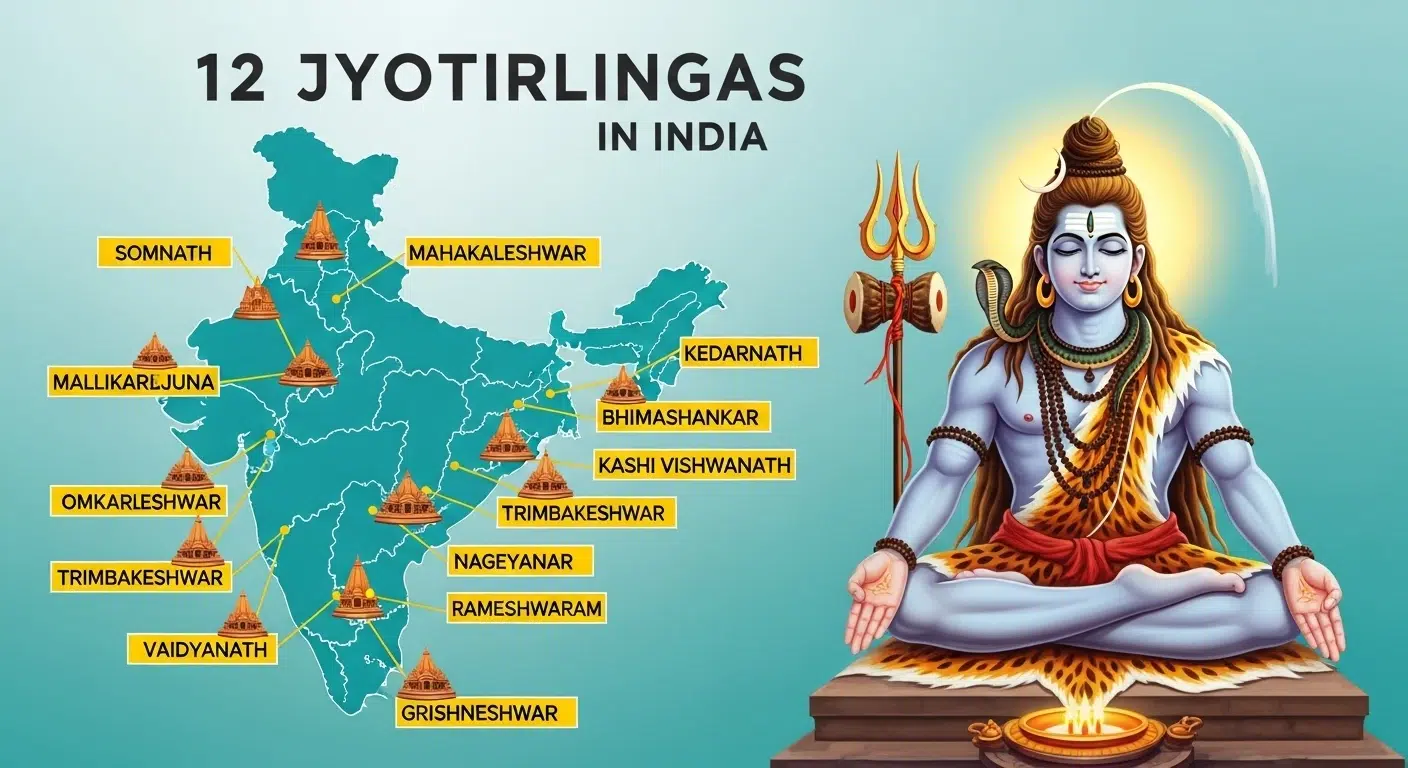A Divine Journey to the 12 Jyotirlingas of India
The twelve Jyotirlingas are the most sacred abodes of Lord Shiva. This guide is designed to help you explore these powerful spiritual centers, providing all the essential information for a fulfilling pilgrimage.
Explore the Jyotirlingas
1. Somnath, Gujarat
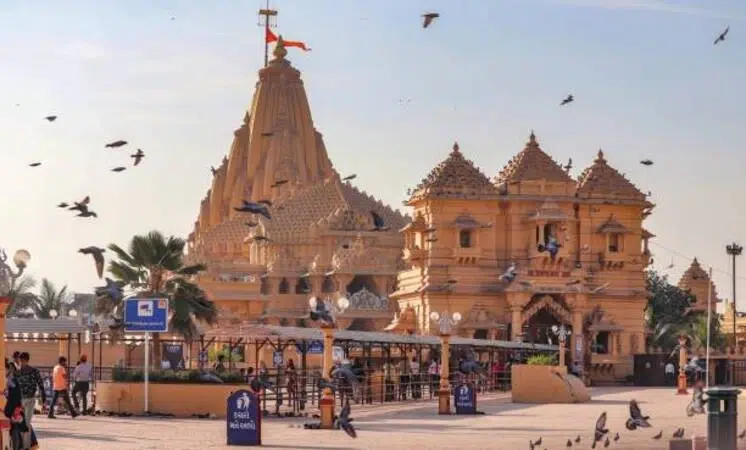
Location
Prabhas Patan, Saurashtra
Deity
Lord Somnath
Best Time
Sept – March
Why Visit This Jyotirlinga?
Visit Somnath to witness the eternal shrine that has withstood the test of time, symbolizing indestructible faith. Its stunning location by the Arabian Sea and the grand evening Aarti make for an unforgettable spiritual experience.
Spiritual Significance
Believed to be the first of the twelve Jyotirlingas, the Somnath temple story is one of resilience. According to legend, the Moon God (Soma) first built the temple in gold after Lord Shiva cured him of a curse from his father-in-law Daksha. The temple is famous for being a testament to undying devotion, having been reconstructed multiple times after invasions. A pilgrimage here is believed to cleanse one of all sins and grant liberation.
Darshan & Travel Info
- Darshan Timings: 6:00 AM – 9:30 PM. Aarti at 7:00 AM, 12:00 PM, and 7:00 PM.
- How to Reach:
- By Air: Nearest airport is Diu (80 km). Keshod Airport (55km) also serves the region.
- By Train: Nearest railway station is Veraval (7 km), well-connected to major cities.
- By Road: State transport buses and private luxury coaches connect Somnath to major cities in Gujarat.
- Nearby Attractions: Bhalka Tirth, Triveni Sangam Ghat, Paanch Pandav Gufa, Gita Mandir.
2. Mallikarjuna, Andhra Pradesh
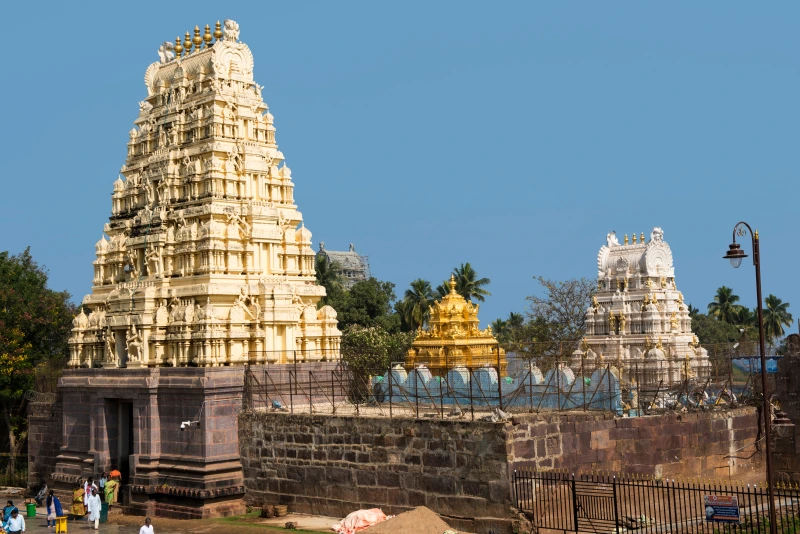
Location
Srisailam
Deity
Mallikarjuna Swamy
Best Time
Oct – Feb
Why Visit This Jyotirlinga?
Visit Mallikarjuna to experience the divine union of Shiva and Shakti. It is one of the rare temples that is revered as both a Jyotirlinga and one of the 18 powerful Shakti Peeths, offering double the spiritual blessings.
Spiritual Significance
Located on the Nallamala Hills, the Srisailam Mallikarjuna temple is famous for being a ‘Swayambhu’ (self-manifested) lingam. The legend says Lord Shiva (as Mallika) and Goddess Parvati (as Arjuna) came here to appease their elder son Kartikeya. Worshipping at this powerful kshetra is believed to grant devotees immense spiritual merit, fulfill their wishes, and liberate them from the cycle of rebirth.
Darshan & Travel Info
- Darshan Timings: 4:30 AM – 10:00 PM (with breaks).
- How to Reach:
- By Air: Nearest airport is Hyderabad (215 km).
- By Train: Nearest railway station is Markapur (85 km).
- By Road: Well-connected by bus services from Hyderabad, Vijayawada, and other major cities in Andhra Pradesh and Telangana.
- Nearby Attractions: Bhramaramba Devi Temple, Pathala Ganga, Akka Mahadevi Caves, Srisailam Dam
3. Mahakaleshwar, Madhya Pradesh
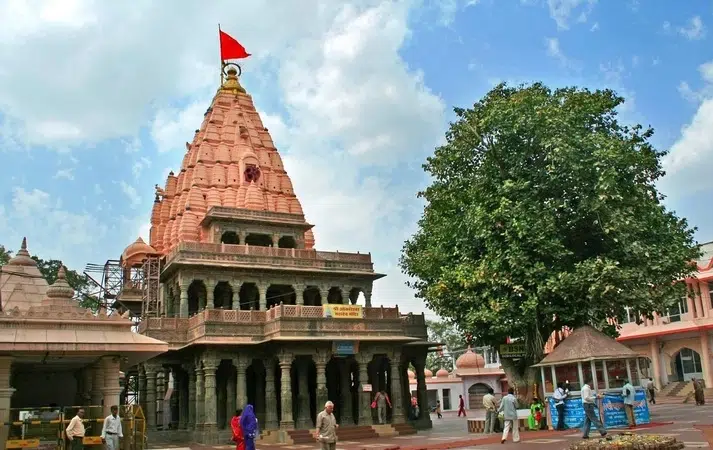
Location
Ujjain
Deity
Lord Mahakal
Best Time
Oct – March
Why Visit This Jyotirlinga?
Visit Mahakaleshwar to witness the one-of-a-kind Bhasma Aarti, a powerful dawn ritual that is an unforgettable sight. As the only south-facing Jyotirlinga, it holds a unique significance for overcoming the fear of death.
Spiritual Significance
Mahakaleshwar in Ujjain is famous for being the only ‘Swayambhu’ (self-manifested) Jyotirlinga that is ‘Dakshinamukhi’ (south-facing). This unique feature makes Lord Shiva the master of time and death. The temple is most famous for its daily Mahakaleshwar Bhasma Aarti, a powerful ritual where the lingam is adorned with fresh ash. Devotees believe that worshipping the Lord of Time, Mahakal, grants a long life and protects from untimely death.
Darshan & Travel Info
- Darshan Timings: 4:00 AM – 11:00 PM. Bhasma Aarti at 4:00 AM (requires pre-booking).
- How to Reach:
- By Air: Nearest airport is Devi Ahilya Bai Holkar Airport in Indore (55 km).
- By Train: Ujjain Junction is a major railway station with direct trains from many cities.
- By Road: Ujjain is well-connected by road to Indore, Bhopal, and other cities in Madhya Pradesh.
- Nearby Attractions: Harsiddhi Temple, Ram Ghat, Kal Bhairav Temple, Jantar Mantar (Vedh Shala).
4. Omkareshwar, Madhya Pradesh
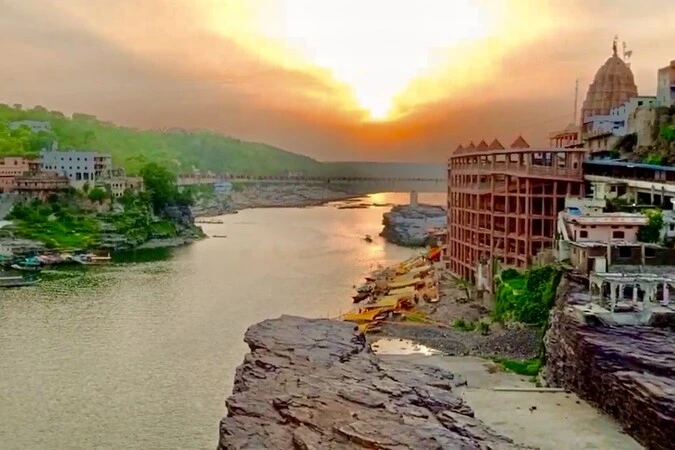
Location
Khandwa
Deity
Lord Omkareshwar
Best Time
Oct – March
Why Visit This Jyotirlinga?
Visit Omkareshwar for its incredibly unique setting on an island shaped like the sacred ‘Om’ symbol in the holy Narmada river. The experience of visiting two temples (Omkareshwar and Mamleshwar) to complete the pilgrimage is unique to this site.
Spiritual Significance
The legend of Omkareshwar Jyotirlinga states that the Jyotirlinga is split into two parts: one as Omkareshwar on the island and the other as Mamleshwar (or Amareshwar) on the south bank of the river. This temple is famous for its unique location and the belief that a pilgrimage is complete only after visiting both temples. Performing a parikrama (circumambulation) of the island is a deeply spiritual practice for devotees.
Darshan & Travel Info
- Darshan Timings: 5:00 AM – 9:35 PM.
- How to Reach:
- By Air: Nearest airport is Indore (80 km).
- By Train: Nearest major railway station is Indore. The closest local station is Mortakka (12 km).
- By Road: Regular buses are available from Indore, Ujjain, and Khandwa.
- Nearby Attractions: Mamleshwar Temple, Siddhanath Temple, Kedareshwar Temple, 24 Avatars Group of Temples.
5. Kedarnath, Uttarakhand
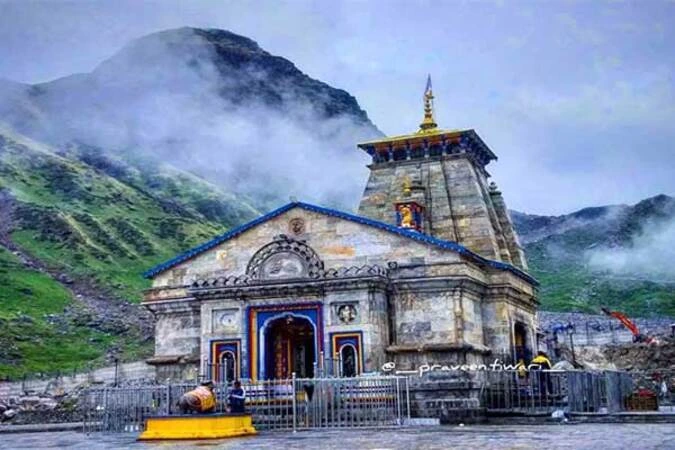
Location
Rudraprayag
Deity
Lord Kedareshwar
Best Time
May – June, Sept – Oct
Why Visit This Jyotirlinga?
Visit Kedarnath for an unparalleled spiritual adventure in the heart of the Himalayas. The challenging trek to the temple is a pilgrimage in itself, rewarding devotees with breathtaking beauty and a profound sense of accomplishment.
Spiritual Significance
Nestled high in the Garhwal Himalayas, Kedarnath Dham is famous for its powerful spiritual vibrations and its connection to the Mahabharata. It is believed the Pandavas, seeking forgiveness from Lord Shiva, built the temple. Shiva, avoiding them, took the form of a bull, and the hump of this bull is worshipped here. As a key part of the Chota Char Dham Yatra, a journey here is believed to grant moksha (liberation).
Darshan & Travel Info
- Darshan Timings: Open from late April/early May to October/November.
- How to Reach:
- By Air: Nearest airport is Jolly Grant Airport in Dehradun (240 km). Helicopter services are available from Phata/Sersi.
- By Train: Nearest railway station is Rishikesh (220 km).
- By Road: Motorable roads go up to Sonprayag/Gaurikund, from where it’s a 16-18 km trek to the temple.
- Nearby Attractions: Vasuki Tal, Shankaracharya Samadhi, Bhairavnath Temple, Triyuginarayan Temple.
6. Bhimashankar, Maharashtra
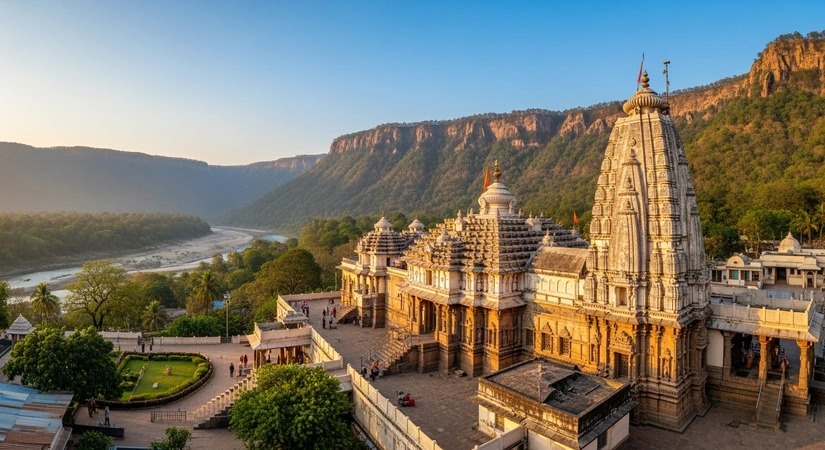
Location
Pune
Deity
Lord Bhimashankar
Best Time
Aug – Feb
Why Visit This Jyotirlinga?
Visit Bhimashankar to experience spirituality amidst pristine nature. The temple is located within a lush wildlife sanctuary, offering a unique opportunity for trekking, bird watching, and seeking divine blessings all in one trip.
Spiritual Significance
Located in the lush Sahyadri hills, the Bhimashankar temple is famous as the source of the Bhima River. It is believed to be the place where Lord Shiva vanquished the demon Tripurasura. The temple is built in the Nagara style of architecture and is renowned for its serene environment within the Bhimashankar Wildlife Sanctuary.
Darshan & Travel Info
- Darshan Timings: 4:30 AM – 9:30 PM.
- How to Reach:
- By Air: Nearest airport is Pune International Airport (110 km).
- By Train: Nearest railway station is Pune Junction (110 km).
- By Road: State transport buses and taxis are available from Pune and Mumbai.
- Nearby Attractions: Bhimashankar Wildlife Sanctuary, Hanuman Lake, Gupt Bhimashankar, Nagphani Point.
7. Kashi Vishwanath, Uttar Pradesh

Location
Varanasi
Deity
Lord Vishwanath
Best Time
Oct – March
Why Visit This Jyotirlinga?
Visit Kashi Vishwanath to immerse yourself in the spiritual heart of India. Located in the ancient city of Varanasi on the banks of the Ganga, a pilgrimage here is considered one of the highest spiritual acts for a Hindu.
Spiritual Significance
The Kashi Vishwanath temple is famous for being located in Kashi (Varanasi), the city of Lord Shiva himself. It is believed that Kashi rests on Shiva’s Trishul (trident) and that dying here grants immediate salvation (moksha). A single glimpse of the Jyotirlinga is considered highly meritorious, making it a primary pilgrimage site for devotees from all over the world.
Darshan & Travel Info
- Darshan Timings: 3:00 AM – 11:00 PM.
- How to Reach:
- By Air: Lal Bahadur Shastri International Airport in Varanasi is well-connected.
- By Train: Varanasi Junction and Manduadih are major railway stations.
- By Road: Varanasi has excellent road connectivity to all major cities in North India.
- Nearby Attractions: Dashashwamedh Ghat (for Ganga Aarti), Sarnath, Assi Ghat, Manikarnika Ghat.
8. Trimbakeshwar, Maharashtra
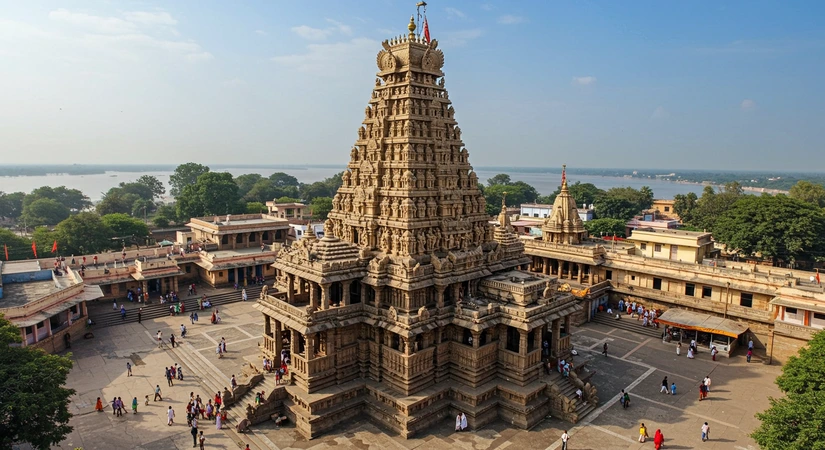
Location
Nashik
Deity
Lord Trimbakeshwar
Best Time
Oct – March
Why Visit This Jyotirlinga?
Visit Trimbakeshwar to worship the unique three-faced lingam representing the holy trinity of Brahma, Vishnu, and Shiva. The temple’s location at the source of the sacred Godavari River makes it exceptionally holy.
Spiritual Significance
The Trimbakeshwar Jyotirlinga is famous for its unique three-faced lingam (Trimurti). It is located at the source of the Godavari river, often called the ‘Ganga of the South’. The legend says Sage Gautama performed a penance to bring the Ganga river here. The temple is also a center for various rituals like Narayan Nagbali, Kalsarpa Shanti, and Tripindi Shraddha.
Darshan & Travel Info
- Darshan Timings: 5:30 AM – 9:00 PM.
- How to Reach:
- By Air: Nearest airport is in Nashik (Ozar Airport, 40 km).
- By Train: Nearest railway station is Nashik Road (30 km).
- By Road: Regular bus services connect Trimbakeshwar with Nashik and other major cities.
- Nearby Attractions: Kushavarta Kund, Brahmagiri Hill, Anjaneri Hill (birthplace of Lord Hanuman), Pandavleni Caves.
9. Vaidyanath, Jharkhand
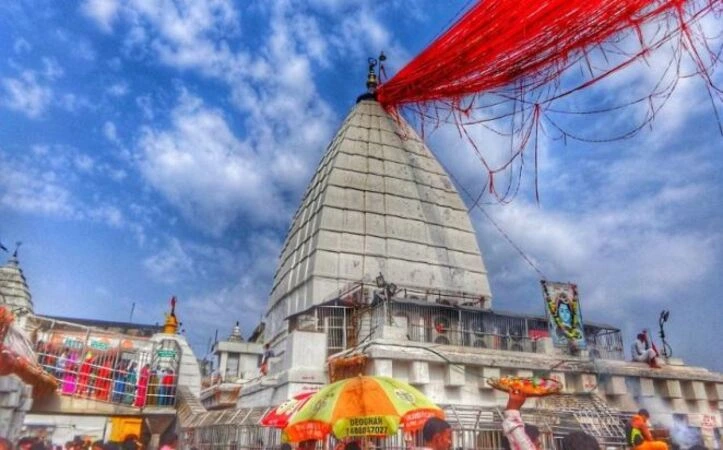
Location
Deoghar
Deity
Lord Vaidyanath
Best Time
Oct – March
Why Visit This Jyotirlinga?
Visit Baidyanath Dham to be part of the vibrant and intense devotion of the Kanwar Yatra during Shravan. As a site that is both a Jyotirlinga and a Shakti Peeth, it holds immense power and is believed to cure ailments.
Spiritual Significance
Also known as Baidyanath Dham, this site is famous for the annual Kanwar Yatra, where millions of devotees carry holy water from the Ganga to offer here. It is believed that the demon king Ravana worshipped Lord Shiva here. The name ‘Vaidyanath’ (Lord of Physicians) comes from a legend where Shiva, in the guise of a tribal man (Bhil), cured Ravana, establishing himself as the ultimate healer.
Darshan & Travel Info
- Darshan Timings: 4:00 AM – 3:30 PM, 6:00 PM – 9:00 PM.
- How to Reach:
- By Air: Deoghar has its own airport with connections to major cities.
- By Train: The nearest major railway station is Jasidih Junction (7 km).
- By Road: Deoghar is well-connected by road to Patna, Ranchi, and Kolkata.
- Nearby Attractions: Basukinath Temple, Trikut Pahar, Nandan Pahar, Satsang Ashram.
10. Nageshwar, Gujarat
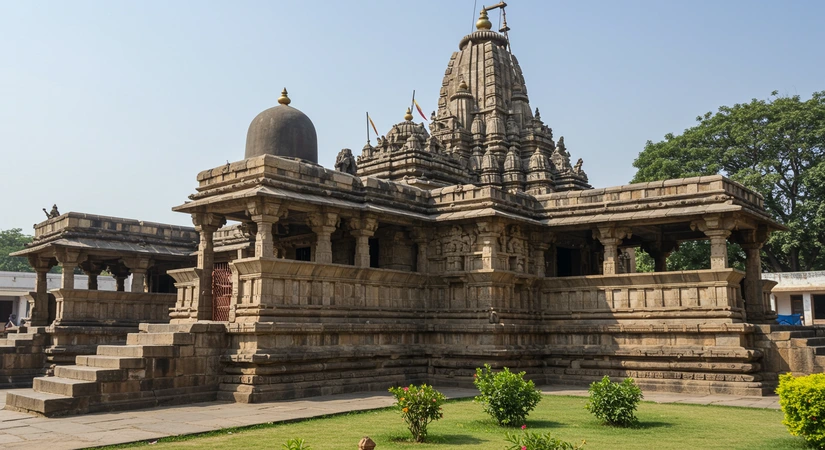
Location
Dwarka
Deity
Lord Nageshwar
Best Time
Oct – March
Why Visit This Jyotirlinga?
Visit Nageshwar to seek protection from all forms of negativity and poisons. The magnificent 82-foot statue of Lord Shiva in a meditative posture provides a powerful and serene presence for devotees.
Spiritual Significance
The Nageshwar Jyotirlinga is famous for its mention in the Shiva Purana as a protector from all poisons. The legend tells of a demon named Daruka who imprisoned a Shiva devotee named Supriya. Shiva appeared here and vanquished the demon, establishing himself as Nageshwar (Lord of Snakes). The temple is a popular stop on the Dwarka pilgrimage circuit.
Darshan & Travel Info
- Darshan Timings: 5:00 AM – 9:00 PM.
- How to Reach:
- By Air: Nearest airport is Jamnagar (130 km).
- By Train: Nearest railway station is Dwarka (17 km).
- By Road: Located on the route between Dwarka city and Beyt Dwarka island, it is easily accessible by road.
- Nearby Attractions: Dwarkadhish Temple, Beyt Dwarka, Rukmini Devi Temple, Gopi Talav.
11. Rameshwaram, Tamil Nadu

Location
Rameswaram Island
Deity
Lord Ramanathaswamy
Best Time
Oct – April
Why Visit This Jyotirlinga?
Visit Rameshwaram to walk in the footsteps of Lord Rama and experience the architectural marvel of its thousand-pillar corridors. Taking a holy dip in the 22 tirthams within the temple complex is a unique ritual believed to wash away sins.
Spiritual Significance
This southernmost Jyotirlinga is famous for its deep connection to the Ramayana. It is believed that Lord Rama installed and worshipped this lingam (Ramanathaswamy) to atone for the sin of killing Ravana. The temple is renowned for its magnificent corridors, the longest in India, and its 22 holy water tanks (tirthams), each with unique properties.
Darshan & Travel Info
- Darshan Timings: 5:00 AM – 1:00 PM, 3:00 PM – 9:00 PM.
- How to Reach:
- By Air: Nearest airport is Madurai (175 km).
- By Train: Rameswaram has its own railway station on the island, connected via the Pamban Bridge.
- By Road: Well-connected by road to all major cities in Tamil Nadu.
- Nearby Attractions: Agnitheertham, Dhanushkodi Beach, Pamban Bridge, Kothandaramaswamy Temple.
12. Grishneshwar, Maharashtra
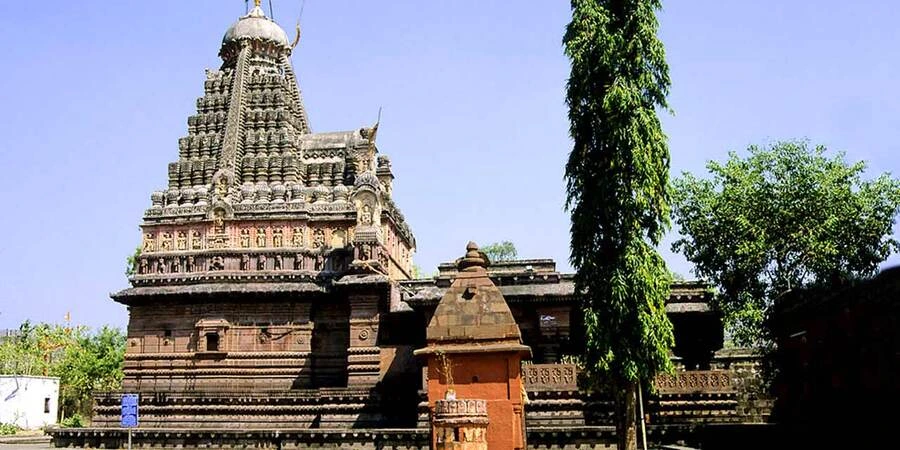
Location
Aurangabad
Deity
Lord Grishneshwar
Best Time
Oct – March
Why Visit This Jyotirlinga?
Visit Grishneshwar, the final Jyotirlinga, to complete the sacred pilgrimage circuit. Its proximity to the world-famous Ellora Caves allows you to combine a deeply spiritual visit with an exploration of ancient Indian art and history.
Spiritual Significance
Located near the UNESCO World Heritage site of Ellora Caves, the Grishneshwar Jyotirlinga is considered the last of the 12 Jyotirlingas. The temple is famous for the legend of a devout woman named Kusuma, whose devotion was so pure that Lord Shiva resurrected her dead son at this very spot. The temple was restored in the 18th century by Rani Ahilyabai Holkar and is a beautiful example of South Indian temple architecture.
Darshan & Travel Info
- Darshan Timings: 5:30 AM – 9:30 PM.
- How to Reach:
- By Air: Nearest airport is Aurangabad Airport (30 km).
- By Train: Nearest railway station is Aurangabad (30 km).
- By Road: Well-connected by road from Aurangabad and other nearby cities.
- Nearby Attractions: Ellora Caves, Daulatabad Fort, Bibi Ka Maqbara, Aurangabad Caves.
Frequently Asked Questions
Q1. What is the significance of the 12 Jyotirlingas?
Ans: The 12 Jyotirlingas are highly revered pilgrimage sites in Hinduism where Lord Shiva is worshipped in the form of a Jyotirlingam, or a ‘pillar of light.’ It is believed that Lord Shiva first manifested himself on Earth on the night of the Aridra Nakshatra, and these 12 locations are where his divine light appeared. Visiting all 12 Jyotirlingas is considered a great spiritual attainment for devotees.
Q2. Can the 12 Jyotirlinga pilgrimage be completed in one trip?
Ans: While it is possible, completing the pilgrimage in a single trip is a significant undertaking due to the vast geographical spread of the temples across India. It would require careful planning and at least 2-3 weeks of dedicated travel. Most devotees visit the temples in regional clusters over several trips.
Q4. Is there a specific order to visit the 12 Jyotirlingas?
Ans: There is no strict, compulsory order for visiting the Jyotirlingas. Devotees often plan their visits based on geographical convenience. However, some traditional texts suggest a sequence starting from Somnath in the west, and many organized tours follow such a path.
Q5. What is the general dress code for visiting Jyotirlinga temples?
Ans: A modest dress code is mandatory. Men are typically required to wear dhoti/pyjamas or trousers, and some temples, like Mahakaleshwar, may require men to remove their shirts for the Garbhagriha (sanctum sanctorum) darshan. Women should wear sarees, salwar kameez, or other traditional attire that covers the shoulders and knees. Western outfits like shorts, skirts, and sleeveless tops are generally not permitted.

